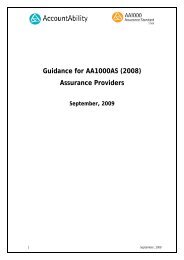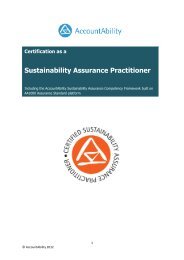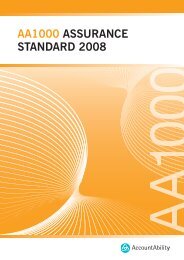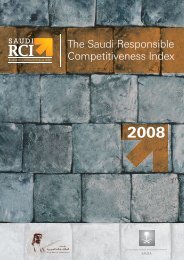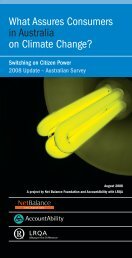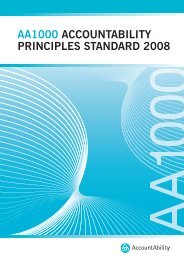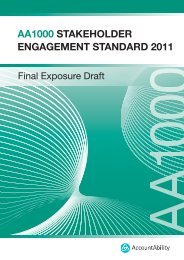The Stakeholder Engagement Manual Volume 2 - AccountAbility
The Stakeholder Engagement Manual Volume 2 - AccountAbility
The Stakeholder Engagement Manual Volume 2 - AccountAbility
You also want an ePaper? Increase the reach of your titles
YUMPU automatically turns print PDFs into web optimized ePapers that Google loves.
P8: UNDERSTANDING AND LEARNING ABOUT STAKEHOLDERS AND THEIR REPRESENTATIVES<br />
BACKGROUND<br />
In order to design stakeholder engagement processes that work, you need<br />
a clear understanding of who your stakeholders are and how and why they<br />
may want to engage with you.<br />
In some cases you will need to engage directly with stakeholders themselves either<br />
as a self-selected or statistically representative sample. In other cases you will<br />
want to engage with stakeholders’ formal or informal representatives in the form<br />
of opinion leaders, elected representatives, community leaders or advocacy or<br />
membership organisations.<br />
Th is section will introduce a more detailed assessment of stakeholders. It will also<br />
include guidance on the selection of appropriate stakeholder representatives to<br />
engage with.<br />
Specifi cally important points to consider are the geographical scales at which<br />
the stakeholder representatives operate and their relationship to the level at<br />
which any outcomes may have to be implemented. For example, in engagements<br />
regarding the global issue of climate change, many of the organisations<br />
representing stakeholders’ viewpoints are themselves large global organisations,<br />
who may not always have the necessary insights into the expectations of local<br />
level stakeholders. In such cases, it is important to ensure that dialogues on<br />
a more local level with local stakeholders are also undertaken which then<br />
complement, feed into and verify the outputs of the global dialogue. 8<br />
When learning more about stakeholder representatives, the following factors<br />
should be considered:<br />
8 See box 4.2, p.53 in <strong>Volume</strong> 1: “<strong>The</strong> Guide to Practitioners’ Perspectives on <strong>Stakeholder</strong> <strong>Engagement</strong>” for further clarifying examples.<br />
STAGE 2<br />
THE PRACTITIONER'S HANDBOOK ON STAKEHOLDER ENGAGEMENT | 65



